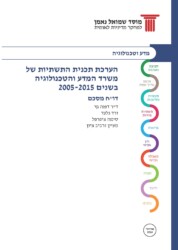The research evaluated the short and long-term effects of research and knowledge centers that received funding from the Ministry of Science, Technology and Space from 2000 to 2010 as part of the infrastructure program.
The scientific infrastructure program of the Ministry of Science, Technology and Space has been operating since 1995 in order to bridge the gap between basic academic research and application development, and aims to reduce the maturation time of applied technological ideas. This study is a continuation of research conducted by SNI in 2005 to examine the economic effects of scientific research and programs conducted as part of the infrastructure program. The study suggests that the program operates in a unique niche, which has succeeded in generating new knowledge leading to developments in applied research. The fields in which the investment yielded particularly good results were stem cells, advanced materials, nanotechnology, optoelectronics, medicine, biotech, and space.
According to the study findings, 75% of the studies continue today and over 95% of the studies created new information in the form of articles, patents, and the creation of new research teams. Based on the knowledge generated in the projects, 30 applications for patent registration were submitted, out of which 21 were registered. In 64% of the studies, an applied outcome was reported (improved technologies, products and services). In addition, in nine studies licenses were given to companies to use the technology and 4% of the funded projects led to the creation of new companies. The research report submitted to the Ministry of Science also included recommendations for improving the program further.



